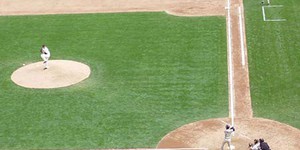Others Like “Relationships Between Variables: Using Correlation and Linear Regression” (top 20 results)
|
Math is used by many different types of scientists to model phenomenon and evaluate data from an experiment. By building mathematical models scientists can understand how different physical, chemical, and biological processes are affected by different variables. The most important tools are: making a graph to give a visual representation of the relationships between your variables and making an equation to give a way of computing the relationships between your variables. Find a source of data,…
Read more
Here's a sports science project that shows you how to use correlation analysis to choose the best batting statistic for predicting run-scoring ability. You'll learn how to use a spreadsheet to measure correlations between two variables.
Read more
What makes a winning team? Getting all the best players? Good coaches? Good chemistry? This project will show you how you can use math to help you test your hypothesis about what makes a winning team.
The Pythagorean relationship is a fundamental one in sports: it correctly predicts the records of 98% of all teams. But in 2% of cases, it fails. Why does it fail? Find teams that deviated substantially from their expected Pythagorean record (this information is available for baseball teams…
Read more
Physics science project: Investigate whether real-life springs behave in a linear fashion, or if the actual behavior of the springs is nonlinear.
Read more
Is there a correlation between birth order and grade point average? Design a survey study to find out. How many completed surveys do you need for a representative sample of your school? If you limit your survey to one school, would you expect it to be representative of a larger population (such as your county or state?) How do you control for potential effects of parental age at birth? (In other words, younger siblings will have a higher probability of being born to older parents. If there…
Read more
A fractal is, "a rough or fragmented geometric shape that can be subdivided in parts, each of which is (at least approximately) a reduced/size copy of the whole" (Mandelbrot, 1982). There are many different fractal patterns, each with unique properties and typically named after the mathematician who discovered it. A fractal increases in complexity as it is generated through repeated sets of numbers called iterations. There are many interesting projects exploring fractal geometry that go beyond…
Read more
You're playing Monopoly with a friend, and you've already got Park Place and you really, really want to get Boardwalk. If you're on Pacific Avenue, what are the chances you'll reach your goal? Here's an easy project that will show you how to find out.
Read more
A magic square is an arrangement of numbers from 1 to n2 in an n x n matrix. In a magic square each number occurs exactly once such that the sum of the entries of any row, column, or main diagonal is the same. You can make several magic squares and investigate the different properties of the square. Can you make an algorithm for constructing a Magic Square? Can you show that the sum of the entries of any row, column, or main diagonal must be n(n2+1)/2? Are there any other hidden properties of a…
Read more
Animals come in all shapes and sizes, even humans. You can look up different statistics about different kinds of animals using the Internet: average body size, brain size, life expectancy and generation time are some examples. Is there a correlation between body size and life span? Is there a correlation between body size and brain size? Is there a correlation between body size and generation time? Is there a correlation between body size and the size of your footprint? (Comparative Mammalian…
Read more
Use your Internet sleuthing skills to learn about solar system objects. Create a table of measurements of moons and asteroids in order to determine if there is a size threshold for roundness. A good source of information would be an online guide such as The Nine Planets (Arnett, W.A., 2006). You'll find information about planetary satellites, including dimensions and accompanying pictures. From the pictures, classify the satellites and asteroids according to how round they are. Can you think of…
Read more
|
Explore Our Science Videos
Potato Battery Science Project
Can You Charge Your Phone with a Potato?
Video: How to Balance Anything





